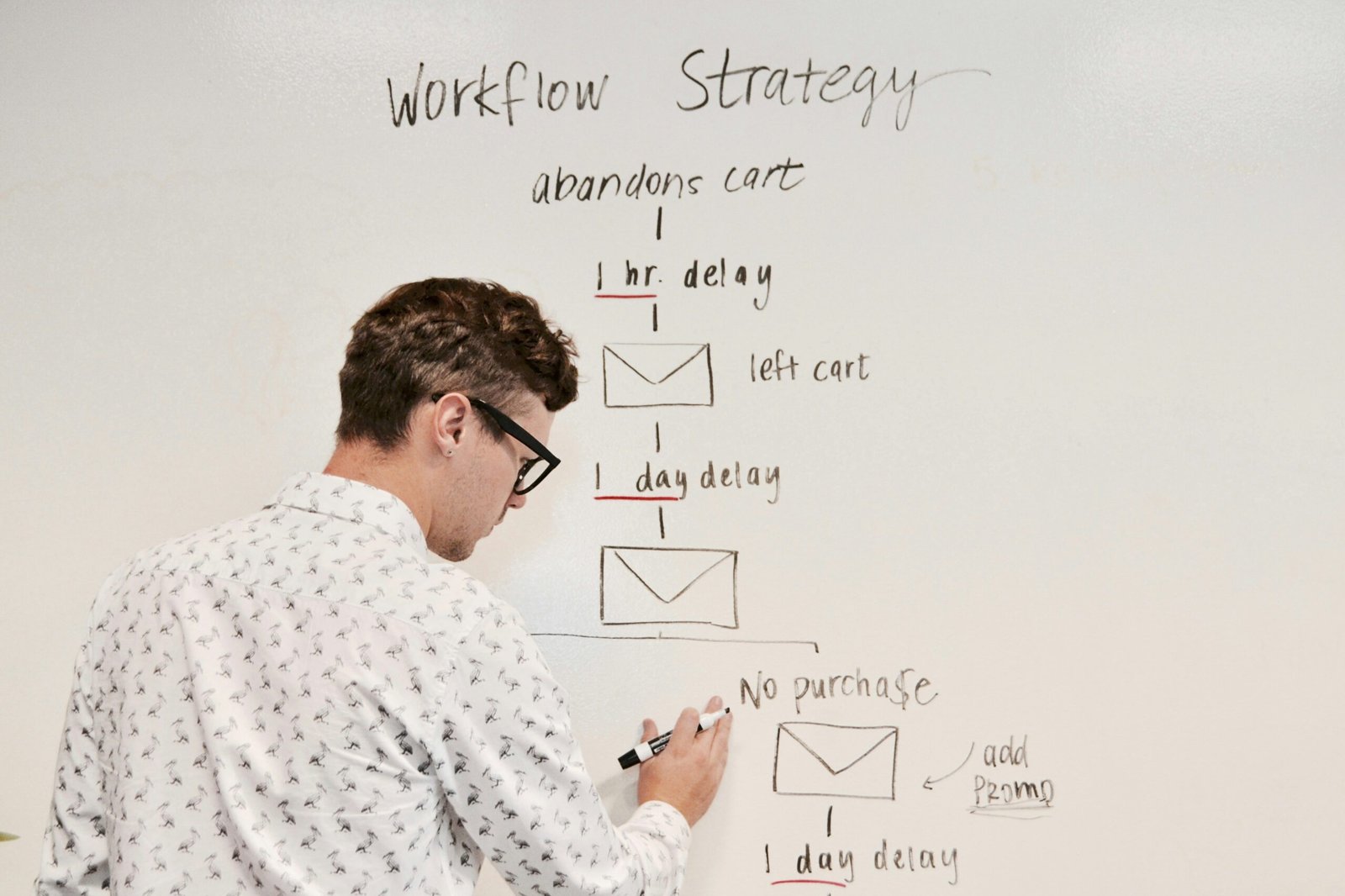Maximizing Profits: The Power of Conversion Rate Optimization for SaaS Companies
Introduction to Conversion Rate Optimization (CRO)
Conversion Rate Optimization (CRO) is a systematic approach aimed at increasing the percentage of website visitors who perform a desired action. This critical practice has gained substantial importance in the digital domain, particularly for Software as a Service (SaaS) companies. In an industry characterized by fierce competition and rapidly evolving technology, understanding and implementing CRO can significantly enhance a company’s profitability.
At its core, CRO involves analyzing user behavior, identifying potential obstacles in the conversion process, and making data-driven adjustments to the website or application. The ultimate goal is to convert more visitors into paying customers, which directly impacts revenue generation. SaaS companies, which often rely on subscriptions, understand that even minor improvements in conversion rates can lead to considerable financial gains.
Importantly, CRO does not merely focus on increasing website traffic, a strategy often associated with digital marketing and advertising campaigns. Instead, it emphasizes optimizing the existing traffic to maximize conversions. This approach is particularly beneficial given the rising costs associated with acquiring new visitors. By investing in CRO, SaaS companies can achieve a higher return on investment by turning current visitors into loyal customers.
Moreover, effective CRO strategies may involve several techniques such as A/B testing, user experience enhancements, and persuasive copywriting. These methodologies aim to create a more engaging and intuitive experience for users, ultimately leading to increased conversions. As SaaS companies navigate the complexities of the digital marketplace, prioritizing conversion rate optimization will be essential in transforming web traffic into tangible revenue streams.
The SaaS Business Model and Its Challenges
The Software as a Service (SaaS) business model has fundamentally transformed how software solutions are delivered and consumed. Unlike traditional software sales, which typically involve a one-time purchase and ownership by the consumer, SaaS offers applications on a subscription basis. This model allows users to access software via the internet, often resulting in lower upfront costs for customers. However, this unique structure comes with distinct challenges that SaaS companies must navigate to achieve sustained growth and profitability.
One of the primary challenges is high customer acquisition cost (CAC). SaaS companies often invest significantly in marketing and sales efforts to attract new customers, which can be particularly daunting in an increasingly competitive space. This financial outlay must be effectively managed, as inefficient spending can lead to lower profit margins. Competing with numerous SaaS vendors that offer similar functionalities necessitates a well-defined value proposition to stand out in a crowded marketplace.
Additionally, customer retention poses a significant challenge for SaaS providers. With subscription models, maintaining ongoing customer satisfaction is imperative; otherwise, clients may choose to switch to alternative solutions. This risk emphasizes the need for effective customer relationship management and continuous innovation to ensure that existing customers remain subscribed and continue to find value in the service offered. The fluctuating nature of customer retention rates can substantially influence revenue predictability and growth trajectories.
Given these challenges, the importance of a robust conversion strategy cannot be overstated. Conversion Rate Optimization (CRO) is vital for SaaS companies aiming to maximize their user base and profitability. By honing in on user experience, optimizing pricing structures, and refining marketing approaches, SaaS companies can substantially improve conversion rates. This strategic focus not only enhances customer acquisition but also plays a critical role in improving retention rates, thereby contributing to overall business stability and growth.
Understanding Your Audience
Effective Conversion Rate Optimization (CRO) begins with a comprehensive understanding of your target audience. The preferences, behaviors, and pain points of potential customers significantly influence their decision-making process. By gaining insights into these facets, SaaS companies can tailor their marketing strategies, ultimately improving conversion rates. One of the most effective methods for achieving this understanding is through user research.
Surveys offer a direct approach to gather qualitative data. By designing questions that probe into users’ challenges, expectations, and experiences, companies can discern specific areas of improvement. For instance, asking users about their motivations for choosing a particular service can reveal key factors that influence their purchasing decisions. This data is invaluable as it helps companies align their offerings with customer expectations, bolstering their conversion strategies.
User feedback is another essential component. After engaging with your software, requests for opinions can provide insights into user satisfaction and highlight areas needing optimization. Implementing feedback loops ensures that the voice of the customer is not only heard but also valued. By actively addressing concerns raised through feedback, SaaS companies can refine the user experience, thereby increasing the likelihood of conversion.
Analytics tools further complement these approaches by furnishing comprehensive data on user behavior. Monitoring metrics such as bounce rates, session durations, and navigation paths enables businesses to identify blockers in the conversion funnel. Understanding where potential customers drop off or lose interest can inform necessary adjustments to streamline the user journey.
In conclusion, understanding your audience is critical for successful conversion rate optimization. By utilizing surveys, user feedback, and analytics, SaaS companies can gain the insights needed to create targeted strategies that resonate with their visitors, enhancing the overall likelihood of conversion and driving profits.
Key Metrics for Measuring Conversion Rate
To effectively measure conversion rates, SaaS companies should focus on several key metrics that provide insights into customer behavior and the overall efficiency of their marketing strategies. The Conversion Rate itself is the primary metric to track, calculated by dividing the number of conversions by the total number of visitors to a particular page or marketing campaign, then multiplying by 100 to get a percentage. A higher conversion rate indicates that a larger proportion of visitors are taking the desired action, be it signing up for a free trial or making a purchase.
Another vital metric is the Customer Acquisition Cost (CAC), which represents the total cost incurred to acquire a new customer. This includes expenses such as marketing and sales efforts. Understanding CAC helps SaaS companies assess whether their investment in marketing is justified based on the revenue generated from new customers.
Equally important is the Lifetime Value (LTV), which estimates the total revenue a business can expect from a customer during their entire relationship with the company. A comparison of LTV to CAC provides insights into the sustainability of a SaaS business model; ideally, the LTV should be significantly higher than the CAC to ensure profitability.
Lastly, Churn Rate measures the percentage of customers who discontinue their subscriptions over a specific period. High churn rates can indicate problems with customer satisfaction or product value. By tracking churn rate alongside the other metrics, SaaS companies can develop strategies to improve retention and enhance user experience.
These metrics interlink in crucial ways: for instance, a low conversion rate might lead to higher CAC and higher churn rates, while improved conversion rates can positively influence LTV. By closely monitoring these key performance indicators, SaaS companies position themselves to make informed, data-driven decisions to optimize conversion rates and maximize profits.
Website and Landing Page Optimization Strategies
Website and landing page optimization play a crucial role in enhancing conversion rates for SaaS companies. By implementing effective strategies, businesses can significantly improve user experience and drive potential customers to take desired actions. A foundational element in this process is A/B testing, which allows companies to compare different versions of website components to determine which performs better. Through this method, companies can analyze variables such as layout, copy, and images, ensuring that they choose options that resonate best with their audience.
Additionally, incorporating compelling call-to-actions (CTAs) is critical for guiding users towards conversion. CTAs should be well-placed and designed to stand out, employing persuasive language that motivates visitors to engage. For example, phrases like “Get Started Free” or “Join Our Community” can create a sense of urgency and entice users to click. Alongside CTAs, it is essential to ensure that the navigation of the website is intuitive, making it easy for users to find the information they seek without confusion. A smooth user journey fosters an environment conducive to conversions.
Another aspect of optimizing websites and landing pages lies in user-centric design. This entails developing layouts that balance aesthetics and functionality, thereby creating a visually appealing yet practical experience. Effective content placement is also vital; critical information should be easily accessible, and the most impactful messages must be highlighted. Crafting persuasive copy that speaks directly to the target audience helps establish connection and trust, further incentivizing visitors to convert. By focusing on these optimization strategies, SaaS companies can cultivate a more effective online presence that drives improved conversion rates.
Leveraging Social Proof and Trust Signals
In the realm of Software as a Service (SaaS) companies, trust is a pivotal factor that influences potential customers’ decisions. One of the most effective strategies for enhancing conversion rates is the implementation of social proof and trust signals. These elements serve to affirm the credibility of your SaaS product and signal to prospective users that others have had positive experiences with your services.
Customer testimonials play a crucial role in building trust. When potential clients read about the experiences of existing users, they are more likely to feel confident in their decision-making process. Displaying these testimonials prominently on your website, especially from recognizable and reputable companies, can significantly enhance your product’s allure. Additionally, video testimonials can add an extra layer of authenticity, as they engage users through visual and auditory means, making the endorsements feel more genuine.
Case studies are another powerful method for showcasing social proof. By presenting in-depth examples of how your software has solved specific problems or generated significant results for other clients, you can help prospective customers visualize the potential benefits of your product. This not only builds confidence in your offerings but also addresses potential objections they might have regarding its efficacy.
Recognition from industry experts can serve as a strong trust signal as well. Awards, certifications, and positive reviews from trusted third-party platforms act as endorsements that can increase credibility. Moreover, displaying security badges, such as secure payment icons or certifications from recognized bodies, reassures customers about the safety of their transactions and data.
By effectively leveraging social proof and trust signals, SaaS companies can significantly enhance their conversion rates. Establishing a foundation of trust and credibility is not merely beneficial but essential in a highly competitive market, ultimately influencing potential customers to engage with your service.
The Role of Analytics in CRO
In the realm of Conversion Rate Optimization (CRO), analytics serve as a fundamental pillar for SaaS companies aiming to enhance their profitability. Through the utilization of sophisticated web analytics tools, companies can scrutinize user interactions and behaviors on their platforms, thereby gaining valuable insights into how potential customers navigate their services. This data-driven approach allows organizations to pinpoint conversion barriers that may hinder users from completing desired actions, such as signing up for a trial or making a purchase.
To effectively leverage analytics in their CRO efforts, SaaS companies should focus on key performance indicators (KPIs) that align with their business objectives. These metrics may include bounce rates, click-through rates, and user engagement levels, among others. By continuously monitoring these KPIs, firms can assess the impact of their website design, content, and user experience on conversion rates. This ongoing analysis is critical for identifying which aspects of the user journey contribute to or detract from conversions.
Moreover, the importance of iterative testing cannot be overstated in the process of optimization. A/B testing and multivariate testing allow SaaS companies to experiment with different elements of their web pages, such as headlines, call-to-action buttons, and layout designs, in a controlled manner. By evaluating the results from these tests in relation to user data, companies can adopt a methodology of constant learning, which is vital for adapting their strategies to meet user needs effectively.
Ultimately, a strong data analytics strategy empowers SaaS organizations to refine their conversion funnels proactively, ensuring they can make informed adjustments that foster user engagement and loyalty. As businesses continuously learn from their data and testing outcomes, the iterative process of CRO becomes a potent mechanism for maximizing profits.
Continuous Improvement and A/B Testing
The landscape of software as a service (SaaS) is constantly evolving, and to remain competitive, companies must embrace a culture of continuous improvement. This involves consistently evaluating and refining their offerings, with a strong emphasis on conversion rate optimization (CRO). A core component of this process is A/B testing, an experimental approach that enables SaaS companies to quantify the effectiveness of different strategies.
A/B testing, or split testing, involves comparing two or more variations of a webpage or interface to determine which one performs better in terms of conversion rates. This can include varying elements like call-to-action buttons, layout designs, content wording, or even color schemes. The critical part of A/B testing is ensuring that each test is conducted systematically, with one variable changed at a time. This allows for valid comparisons and accurate interpretation of results.
To effectively implement A/B testing, SaaS companies should begin by identifying specific goals for each test. These could range from increasing subscription sign-ups to enhancing user engagement. Once these objectives are clear, teams can devise hypotheses centered around potential changes that might improve these metrics. It’s also essential to define key performance indicators (KPIs) to measure the success of each variant accurately.
After launching the A/B tests, companies must monitor the performance of the variations over a predetermined period, ensuring that sufficient traffic is allocated to each version for reliable data. Analyzing results involves not just looking at raw conversion numbers but also understanding user behaviors and trends to gain insight into what drives customer decisions. This data-driven approach fosters a culture of experimentation, empowering SaaS companies to make informed decisions that directly enhance their sales processes.
Through regular A/B testing and continuous improvement, SaaS companies can stay agile, adopting best practices that drive conversions and ultimately maximize profits in a competitive marketplace.
Conclusion: Turning Traffic into Revenue
In the ever-evolving landscape of the Software as a Service (SaaS) industry, maximizing revenue is pivotal to sustaining growth and maintaining a competitive edge. Conversion Rate Optimization (CRO) emerges as a crucial strategy in this endeavor, offering the potential to significantly enhance the profitability of existing traffic without necessitating increased investment in user acquisition. As discussed throughout this blog post, a meticulous approach to CRO allows SaaS companies to identify and rectify inefficiencies in their sales funnels, thereby transforming passive visitors into valuable, paying customers.
The importance of understanding user behavior cannot be overstated. By leveraging analytics and testing different strategies, businesses can gain profound insights into what drives user engagement and conversion. Implementing targeted improvements such as streamlined landing pages, personalized user experiences, and effective call-to-action elements can markedly increase conversion rates, ultimately leading to increased revenue.
Moreover, prioritizing CRO not only leads to immediate financial benefits but also fosters long-term customer loyalty. Satisfied customers are more likely to engage in recurring subscriptions, upgrade services, and refer new clients, creating a virtuous cycle of growth. Therefore, it is imperative for SaaS companies to embed CRO into their overarching digital strategy, viewing it as a continuous process rather than a one-time effort.
As you reflect on the insights shared, consider this your call to action: begin implementing the strategies outlined in this blog post to boost your conversion rates. By committing to a structured CRO approach, you can unlock the full potential of your existing traffic, turning it into tangible revenue streams that contribute to your company’s success. Embrace the transformative power of Conversion Rate Optimization and watch your SaaS business thrive in a highly competitive market.







